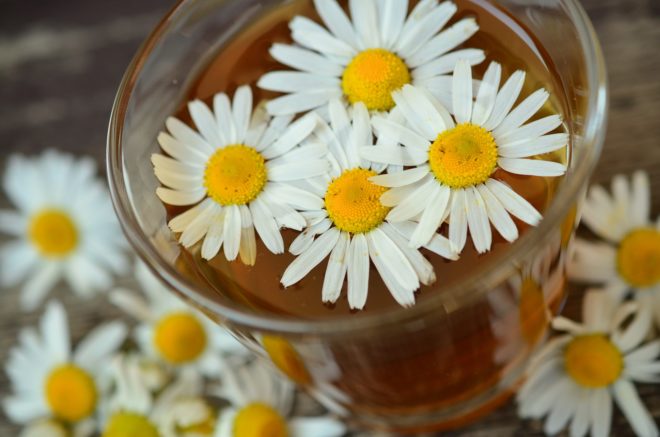There is a plethora of ways to relax and let go of tension. Mediation, walking in nature, meeting friends, reading, gentle exercise, swimming, and yoga are all time-honoured ways to relax. Relaxation can be enhanced by incorporating in herbs. There are many herbs one can choose from the vast Botanical Apothecary to relax.
Today We Are Featuring 5 Herbs For Relaxation.
1. Chamomile
Scientific name: Matricaria chamomilla also known as Matricaria recutita, German chamomile or wild chamomile, the most commonly-used species. For centuries people have used Chamomile for healing.
The dry chamomile flower is known for its anti-inflammatory, antioxidant, antifungal, antispasmodic, anti-ulcer, and astringent healing properties.
The presence of many flavonoids, sesquiterpenes, and other powerful antioxidants, which can have significant effects on the body. This herbal tea besides being delicious, is wonderful as a relaxation, stress, and anxiety tea treatment.
After a long day at work, the warm, soothing nature of this beverage can help increase the levels of serotonin and melatonin in the body, which can successfully eliminate stress and worry, while also slowing down the mind and eliminating the classic symptoms of anxiety.
1-2 cups of chamomile tea per day can do a significant help against your chronic stress symptoms.
Chamomile Tea: 1 heaped teaspoon dried chamomile flowers in 250 ml fresh, delicious water, brought just to the boil. Optional additions to taste, such as honey, lemon, or mint.
Precautions: Do not use the oil during pregnancy as it is a uterine stimulant. Chamomile can have a sedating effect on the body and can cause drowsiness.
Do not use while driving, operating heavy/precision machinery, or performing any other activity requiring a high, acute, level of awareness. Chamomile causes contact dermatitis in some people, especially when fresh and frequently handled.
Compositae in general are allergenic to some people. This includes other common herbs such as dandelion and echinacea. Long term use may result in ragweed allergy. Do not use at all if you are allergic to ragweed.
Consult your healthcare practitioner if you have any concerns about using this herb.
2. Lavender
Scientific name: Lavandula, part of the family, Lamiaceae. This is a beautiful herb for relaxation. Inhaling the evaporated essential oil of this plant can eliminate nervous tension and treat respiratory issues.
The plant has a calming effect on the brain, helpful with anxiety, depression, insomnia, and general restlessness. It’s also useful for people who have hypertension as it lowers blood pressure whilst encouraging healthy circulation.
It is known aromatic, carminative, sedative, bitter, antidepressant, hypnotic, cholagogue, anti-microbial and nervine properties.
Lavender Tea: To make lavender tea, you can either use a saucepan or a teapot. Add four cups of water and two tablespoons of lavender flowers. Let the water boil and then allow the tea too steep for at least 15 minutes.
Strain and then serve. It can also be chilled to make iced Lavender tea.
Precautions: Precautions of Lavender Essential Oil – Always test for skin sensitivity prior to widespread use and use on the feet when possible. Excessive use of any oil can lead to skin sensitization.
Keep out of eyes, ears, or nose. Not all oils are created equally, so test brands carefully, and never use an oil in a way not recommended by its maker. It is not advised for use in pregnant or nursing mothers.
Oral use of Lavender may cause constipation, headache, and increased appetite. Lavender oil is toxic if taken orally.
3. Lemon Balm
Scientific name: Melissa officinalis, belongs to the Lamiaceae family. A citrusy and fresh scented herb has been used for centuries to treat anxiety, sleep disorders, indigestion, and wounds. It soothes the nervous system in an effective and yet gentle way.
The essential oil enhances the feeling of relaxation. It is known as a nervine, sedative, antiviral, carminative, diaphoretic, antispasmodic and anti-depressive.
It has also been shown to enhance cognitive performance through its actions on acetylcholine receptors in the brain.
Lemon Balm Tea: 1 heaped tablespoon of dried leaves or 2 tablespoons of fresh leaves for each cup of boiling water strain add honey and, or lemon.
Precautions: The use of herbs is a time-honoured approach to strengthening the body and treating disease. Herbs, however, contain components that can trigger side effects and interact with other herbs, supplements, or medications.
For these reasons, you should take herbs with care, under the supervision of a health care provider qualified in the field of botanical medicine. Pregnant and breastfeeding women should not take lemon balm.
4. Schisandra
Scientific name: Schisandra. The Chinese name for schizandra is Wu Wei Zi, which means “five flavour fruit.” This is due to the fact that schizandra contains all of the five tastes: salty, sweet, bitter, pungent and sour. Schisandra is a wonderful herb that has been used for thousands of years in Traditional Chinese Medicine to treat a wide range of ailments. This wonderful herb reduces levels of stress hormones in the blood, regulate blood pressure. When taken long-term, schisandra can help to repair a frazzled nervous system and enhance the body’s overall performance. It is known as an Adaptogen, anti-inflammatory, antifungal, antiviral and antioxidant activity.
Schisandra Tea: Simmer 1 to 2 Tablespoons of the dried berries in 2 cups of water in a small, covered saucepan for 15 to 20 minutes.
Precaution: While schisandra is relatively safe to consume for a wide range of people, it should be avoided when pregnant as it is a uterine stimulant. It may be appropriate to seek the advice of a qualified herbalist for additional assistance, when creating individualized herbal formulations for specific health conditions. Consult your healthcare practitioner, before using schisandra, if you are taking prescription medications or have a serious medical illness.
5. Holy Basil/Tulsi
Scientific Name: Ocimum Sanctum a member of the mint family. It is also referred to as the “Queen of Herbs”, “Mother Medicine of Nature” and the “The Elixir of Life.” Holy Basil is one of the most sacred plants in India. In Hinduism, Holy Basil is worshiped as the incarnation of Lakshmi, the wife of Vishnu and one of that religion’s most important deities.
It smells strongly of cloves or cinnamon which is probably due to the high amount of eugenol, rosmarinic acid, and linalool. It is considered an excellent adaptogen, which means that it helps the body adapt to stresses, restore balance, and normalize functions.
Traditionally it has been used in Ayurvedic medicine for its antibacterial, fever-reducing, headaches, stomach disorders, inflammation, heart disease, various forms of poisoning, and respiratory health qualities.
Chronic stress has been shown to increase the levels of oxidative stress and free radicals. Holy basil enhances the levels and activities of endogenous antioxidants and antioxidant enzymes including glutathione and superoxide dismutase.
It is an adaptogen, anti-inflammatory, antiviral, antibacterial, anti-fungal, antioxidant.
Holy Basil Tea: Cover 2 teaspoons of fresh Holy Basil leaves with 230 ml of boiling water, then cover and let steep for about 10 minutes before straining the leaves off and drinking or 1 tablespoon of dried herb to each cup of water.
Holy Basil Iced Tea use 230 ml of water and 1 tablespoon dried tea as your guide for how many cups you want to make. Place holy basil tea into a saucepan, bring to a gentle boil, then remove from the heat and steep for 10 minutes.
Then strain with a fine mesh strainer into a covered glass pitcher and chill in the refrigerator. Slice a few lemons to serve with each glass or float on the top of the iced tea.
Precautions: Holy Basil can slightly thin the blood and shouldn’t be taken by people taking blood thinning medications. It may also lower the blood sugar and shouldn’t be taken by anyone with hypoglycemia. It may decrease fertility and should never be taken by women trying to conceive. Pregnant and breastfeeding women should not take Holy Basil.
You can find much more information on living a holistic lifestyle in these free magazines and on our YouTube channel.
 Irene Vervliet – Naturopathic Doctor
Irene Vervliet – Naturopathic Doctor
Reference
Agrawal P, et al. (1996) ‘Randomized placebo-controlled, single blind trial of holy basil leaves in patients with noninsulin-dependent diabetes mellitus’. Int J Clin Pharmacol Ther 1996; 34(9):406-9.
Amsterdam J.D, Li Y et. al (2009), ‘A Randomized, double blind, Placebo controlled trial of oral? Matricaria Recutita (Chamomile) Extract therapy of Generalized Anxiety Disorder’. https://www.ncbi.nlm.nih.gov/pmc/articles/PMC3600416/
Bhattacharyya D1, Sur TK, Jana U, Debnath PK. ‘Controlled programmed trial of Ocimum sanctum leaf on generalized anxiety disorders’.; Nepal Med Coll J. 2008 Sep;10(3):176-9. http://www.ncbi.nlm.nih.gov/pubmed/19253862
Cohen M.M. (2014) ‘Tulsi – Ocimum sanctum: A herb for all reasons’ https://www.ncbi.nlm.nih.gov/pmc/articles/PMC4296439/
Group E. (2015), ‘9 Impressive Health Benefits of Lemon Balm’. https://www.globalhealingcenter.com/natural-health/9-benefits-of-lemon-balm/
Lavender (2017), http://www.botanical.com/botanical/mgmh/l/lavend13.html
Lavender Actions (2010) http://medicinalplants.us/lavender-actions
Lee T.H.,Jung CH and Lee D.H. (2012), Neuroprotective effects of Schisandrin B against transient focal cerebral ischemia in Sprague-Dawley rats. https://www.ncbi.nlm.nih.gov/pubmed/22960133
Manikandan P, et al. Ocimum sanctum Linn. (2007), ‘(Holy Basil) ethanolic leaf extract protects against 7, 12-dimethylbenz(a)anthrace ne-induced genotoxicity, oxidative stress, and imbalance in xenobiotic-metabolizing enzymes’. J Med Food; 10(3):495-502.
Panossian A. Hambardzumyan et. al. (2007), ‘The Adaptogens Rhodiola and Schizandra Modify the Response to Immobilization Stress in Rabbits by Suppressing the Increase of Phosphorylated Stress-activated Protein Kinase, Nitric Oxide and Cortisol’. https://www.ncbi.nlm.nih.gov/pmc/articles/PMC3155223/
Prasad MP and Khanum F. (2012), ‘Antifatigue Activity of Ethanolic Extract of Ocimum sanctum in Rats; MP; Research Journal of Medicinal Plant, Volume: 6. Issue: 1, Page No.: 37-46
http://scialert.net/abstract/?doi=rjmp.2012.37.46
Noor S. and Field (2013), Lemon Balm Tea – Uplifting, Relaxing and Memory Enhancing
https://permaculturenews.org/2013/10/18/lemon-balm-tea-uplifting-relaxing-memory-enhancing/
Panossian A., Wikman G. (2008)
Pharmacology of Schisandra chinensis Bail.: an overview of Russian research and uses in medicine. https://www.ncbi.nlm.nih.gov/pubmed/18515024
The Chopra Center, ‘What is Holy Basil?’ http://www.chopra.com/articles/what-is-holy-basil#sm.001pykg63kfpcqx11aa2rfn9dzmc1
UMM, (2015) ‘Lemon balm’, http://www.umm.edu/health/medical/altmed/herb/lemon-balm
UMM, (2015) ‘Lavender’ http://www.umm.edu/health/medical/altmed/herb/lavender






